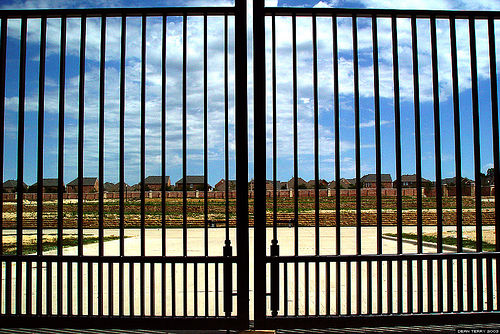The anti-community “community”

Posted August 11, 2009 at 1:33PM
I sort of get it about "gated communities." In some ways it's not that different from having security at the entrance to an apartment building, I suppose. I definitely get it if you're a person with special vulnerability, or a celebrity who can't otherwise find privacy. I have a little harder time, but I can kind of get it if announcing your financial status to the world is important to you, or if you're an uber-control freak who doesn't want to come into contact with anyone or anything that isn't utterly anticipated and welcomed.
But I get a bit offended at the use of the word "community" to describe and market sprawling suburban bastions of exclusivity that, in effect, bar entry to those of insufficient wealth or access. To me, that is not community but condescension. These places announce to the world that, although their streets may look like public streets, there is nothing public and certainly nothing welcoming about their domain.
There is also an environmental problem with these developments, because their gates restrict the connectivity of one place to another, lengthening driving trips, preventing the placing of businesses that one might walk to within their boundary, and excluding transit within the restricted area.
In Oklahoma City, apparently there is even a gated subdivision that is gated from itself. Steve Patterson describes his brother's neighborhood, photo above, on UrbanReviewSTL:
"My brother's subdivision, located in a far sprawling area within Oklahoma City's huge city limits, is a curiosity to me. No doubt we have similar subdivisions in the St. Louis region. Every region in the US likely has a similar situation.
"The subdivision is gated. Not just to outsiders but from one part to another - wouldn't want the Riff Raff from 3 blocks away in our part of the same subdivision.
"The sidewalks don't leave the subdivision because the major roads outside the subdivision lack sidewalks. I can see the grocery store from his front walk but to get there requires a car trip.
"Although they have plenty of room between the curbs & sidewalks, they have zero street trees. Apparently tree-lined streets are a bad thing? The one decorative tree in each front lawn is kept back so it can't won't shade the sidewalk.
"The streets are not public but are privately owned & maintained by the home owners. All houses have 3-car garages - the minimum allowed. You can leave a non-commercial vehicle on your driveway but don't think of leaving your car on the too wide subdivision streets overnight. Commercial vehicles (company SUV with name on the side, for example) must be kept in the garage.
"The logic goes that parked cars on the street overnight is low class and tacky. To protect their home values, the streets must be free of vehicles. They live in an environment where the car is a must but they don't want to see the cars at night."
Go here for the full post.
Even though I sort of get it, I don't think I'd like living in such a highly controlled environment for long. Apart from not being able to walk places, for me part of what makes a true community is coming into contact with others who are part of what makes the place function, but whom I may not already know and who have diverse incomes and are in diverse stages of life. The sheer randomness of encountering another cyclist who may just be passing through, to cite just one example, gives the place a vitality that these highly controlled environments lack. If the place is only about me and those I choose to invite, it doesn't fit my definition of "community." It's just sprawl by another name.

